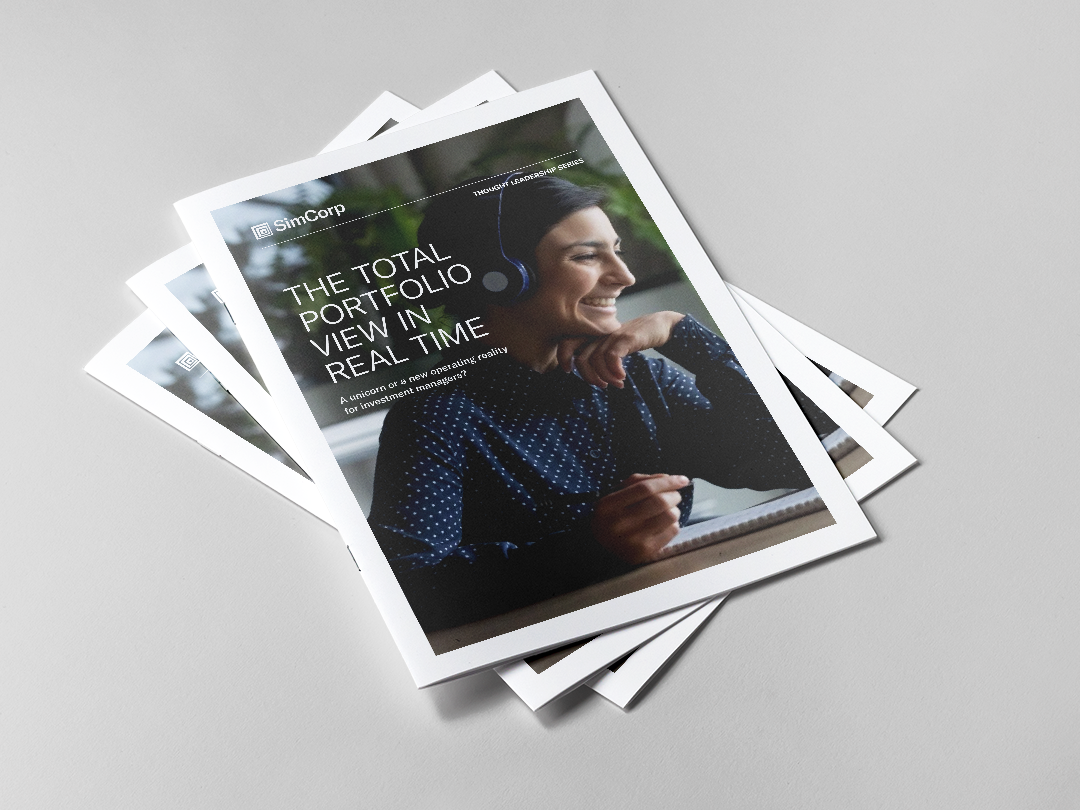

T+1 settlement and beyond: Can your operating model handle the change?
Author
Alan Copping
GTM Senior Strategy Principal, SimCorp
Three weeks into the T+1 go-live in North America, the global financial community is closely monitoring the transition. The initial response from market participants has been overwhelmingly positive.
For the UK and the European Union, the shift to T+1 settlement is no longer a matter of “if,” but rather “when” and “how.” In a roundtable held by the European Commission earlier this year, 65 percent of attendees said the EU cannot maintain its attractiveness in the long term without improving settlement efficiency.
Both regions have established taskforces to assess the impact of shortening the settlement cycle. The UK aims for a T+1 go-live by the end of 2027, while the EU will review key findings in early 2025. In Asia, excluding Hong Kong and India, adoption is likely, albeit with additional challenges due to time zone differences.
However, T+1 is not a standalone solution. The risk of settlement failures begins well before the settlement process itself. Issues such as late trades, low straight-through processing (STP) rates, fragmented infrastructure, and the lack of a global “follow the sun” approach persist. Despite automated trade workflows, manual and cumbersome exception handling remains prevalent. Technical connectivity issues within the broader ecosystem of market participants further compound these challenges.
How to ensure you get through this and the next regulatory change
T+1 is but one of many regulatory or market driven changes you will encounter going forward. You need to future proof your operating model to be ready for whatever challenge your business encounters as well as innovate when you decide you want to lead rather than follow. So, when market practices change, can you handle it?
The first step for the buy side is to prioritize automation, transparency, and efficiency across the entire investment value chain. Real-time visibility into late, partial, and actual settlements across asset classes and transaction types is crucial. Automated communication and predictive tools for settlement failures are essential. Seamless connectivity and data interoperability with custodians and counterparties enable informed investment decisions.
In summary, embracing T+1 requires a holistic approach that extends beyond mere settlement mechanics to the broader operational complexities within the organization. With the right technology partner, firms can navigate these changes successfully and position themselves for the future.
There are four key areas that require buy-side firms’ attention today:
- Real-time data accessible from a front to back investment management platform
This you can address by adopting a centralized investment management platform covering the full investment management lifecycle, with a single Investment Book of Record (IBOR) and Accounting Book of Record (ABOR) that supports business functions across all asset classes and geographies. Such an integrated multi-asset platform is the foundation for enabling a real-time total portfolio view and real-time data access across the organization, minimizing the impact of T+1 changes in areas such as FX, funding, and corporate actions, which – for T+1 purposes - means that changes to settlement times can be handled quickly, efficiently, and automatically. - Market connectivity providing enhanced, enriched and standardized data for maximum STP
Ensure that your technology architecture is optimized for maximum STP. Optimal solutions for T+1, and investment processing in general, provide easy connectivity to a vast array of venues, custodians, and counterparties, resulting in better data quality, higher STP rates, and enhanced exception handling. - Follow the sun operating model
For those in EMEA and Asia/Oceania, adopting a follow the sun approach to ensure that T+1 obligations are met is the optimal solution. This may include establishing an operations team in the Americas that operates in the local time zone or utilizing a vendor’s service to leverage their follow the sun model. - Leverage the open ecosystem to speed up the innovation process
No single solution provider can cover all possible needs you may have. The most progressive providers offer an open ecosystem, which allows firms to extend the capabilities of their existing platforms with pre-integrated innovative technology from fintech providers, without the costs of undertaking their own integration. This gives you the freedom to select the partners that best fit with your investment workflows and T+1 compliance needs.
To learn more about how SimCorp One can help you navigate regulatory changes like T+1, please reach out to us. We’ll share how we’re helping buy-side firms across the globe become T+1 compliant, as well as discuss how we can best assist based on your current and future state operating model.
Three weeks into the T+1 go-live in North America, the global financial community is closely monitoring the transition. The initial response from market participants has been overwhelmingly positive.
For the UK and the European Union, the shift to T+1 settlement is no longer a matter of “if,” but rather “when” and “how.” In a roundtable held by the European Commission earlier this year, 65 percent of attendees said the EU cannot maintain its attractiveness in the long term without improving settlement efficiency.
Both regions have established taskforces to assess the impact of shortening the settlement cycle. The UK aims for a T+1 go-live by the end of 2027, while the EU will review key findings in early 2025. In Asia, excluding Hong Kong and India, adoption is likely, albeit with additional challenges due to time zone differences.
However, T+1 is not a standalone solution. The risk of settlement failures begins well before the settlement process itself. Issues such as late trades, low straight-through processing (STP) rates, fragmented infrastructure, and the lack of a global “follow the sun” approach persist. Despite automated trade workflows, manual and cumbersome exception handling remains prevalent. Technical connectivity issues within the broader ecosystem of market participants further compound these challenges.
How to ensure you get through this and the next regulatory change
T+1 is but one of many regulatory or market driven changes you will encounter going forward. You need to future proof your operating model to be ready for whatever challenge your business encounters as well as innovate when you decide you want to lead rather than follow. So, when market practices change, can you handle it?
The first step for the buy side is to prioritize automation, transparency, and efficiency across the entire investment value chain. Real-time visibility into late, partial, and actual settlements across asset classes and transaction types is crucial. Automated communication and predictive tools for settlement failures are essential. Seamless connectivity and data interoperability with custodians and counterparties enable informed investment decisions.
In summary, embracing T+1 requires a holistic approach that extends beyond mere settlement mechanics to the broader operational complexities within the organization. With the right technology partner, firms can navigate these changes successfully and position themselves for the future.
There are four key areas that require buy-side firms’ attention today:
- Real-time data accessible from a front to back investment management platform
This you can address by adopting a centralized investment management platform covering the full investment management lifecycle, with a single Investment Book of Record (IBOR) and Accounting Book of Record (ABOR) that supports business functions across all asset classes and geographies. Such an integrated multi-asset platform is the foundation for enabling a real-time total portfolio view and real-time data access across the organization, minimizing the impact of T+1 changes in areas such as FX, funding, and corporate actions, which – for T+1 purposes - means that changes to settlement times can be handled quickly, efficiently, and automatically. - Market connectivity providing enhanced, enriched and standardized data for maximum STP
Ensure that your technology architecture is optimized for maximum STP. Optimal solutions for T+1, and investment processing in general, provide easy connectivity to a vast array of venues, custodians, and counterparties, resulting in better data quality, higher STP rates, and enhanced exception handling. - Follow the sun operating model
For those in EMEA and Asia/Oceania, adopting a follow the sun approach to ensure that T+1 obligations are met is the optimal solution. This may include establishing an operations team in the Americas that operates in the local time zone or utilizing a vendor’s service to leverage their follow the sun model. - Leverage the open ecosystem to speed up the innovation process
No single solution provider can cover all possible needs you may have. The most progressive providers offer an open ecosystem, which allows firms to extend the capabilities of their existing platforms with pre-integrated innovative technology from fintech providers, without the costs of undertaking their own integration. This gives you the freedom to select the partners that best fit with your investment workflows and T+1 compliance needs.
To learn more about how SimCorp One can help you navigate regulatory changes like T+1, please reach out to us. We’ll share how we’re helping buy-side firms across the globe become T+1 compliant, as well as discuss how we can best assist based on your current and future state operating model.
References:
1: https://www.tradersmagazine.com/am/us-t1-spurred-operational-efficiency-automation/
2: https://www.waterstechnology.com/regulation/7951655/when-not-if-eu-plots-course-for-t1-transition
Related content


